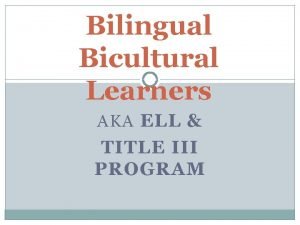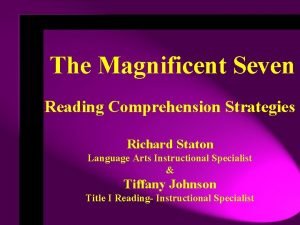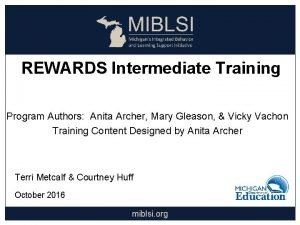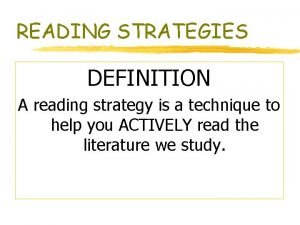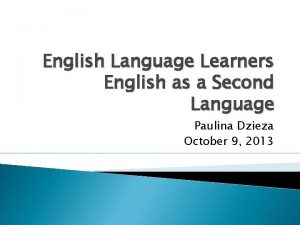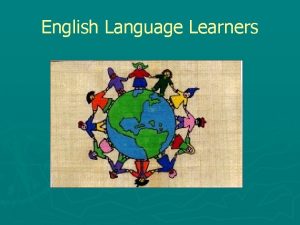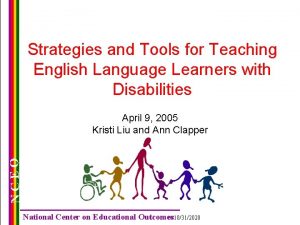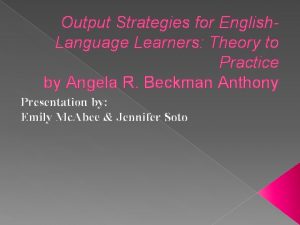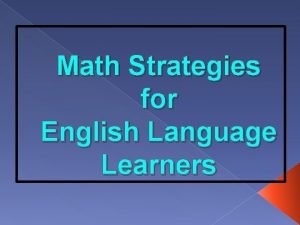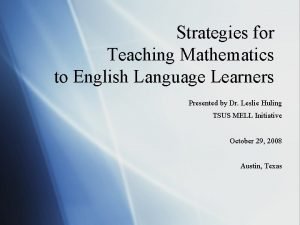Reading Strategies Used With English Language Learners with















- Slides: 15

Reading Strategies Used With English Language Learners with Learning Disabilities Libbey Horton and Jennifer Buxton George Mason University

Background Literature • ELLs represent 400 different language groups, and Spanish speakers make up 75% of the ELL population (Kindler, 2002). • In recent years, the ELL population has increased 70% to 5. 5 million students in American schools (Calhoon et al. , 2007). • 60% of Spanish speaking fourth graders have significant decoding deficits and do not have basic reading skills (Calhoon et al. , 2007).

Background Literature • According to national data, 76% of third-grade ELLs were performing below grade level in English reading (Zehler, Fleischman, Hopstock, Stephenson, et al. , 2003). • Approximately 40% to 50% of Latinos between the ages of 15 and 17 are enrolled in below grade level classes (Heubert &Hauser, 1999). • 80% of ELLs are Spanish speakers. Spanish speaking ELLs are twice as likely as English speakers to read below grade level (Calhoon et al. , 2007).

Background Literature • Fitzgerald’s research (1995) reported that ELLs could be effectively instructed using the same interventions that are used with monolingual students. • Although much is known about reading interventions that target monolingual speakers, less is known about teaching ELLs who struggle with reading (Linan -Thompson, Vaughn, Hickman-Davis, & Kouzekanani, 2003).

The Power of Assessments • Assessments should drive instruction. ELLs with LD are often reading significantly below grade level. Targeted interventions are key. • Some Possible Assessments to use: • • Curriculum Based Assessments DIBELS Woodcock Reading Mastery Comprehension Test of Phonological Processing-Spanish Qualitative Reading Inventory Developmental Reading Assessment Diagnostic Spelling Assessment

Small Group Direct Instruction • Small group direct instruction has been used effectively in many studies (Kamps et al. , 2007; Santoro et al. , 2006; Cirino et al. 2009) • One-to-one instruction or one-to-three instruction is most effective (Wanzek and Vaughn, 2008). • A variety of interventions can be used to effectively remediate students in small groups. • Ex: Ladders to Literacy, Read Well, word study, etc…

Supplemental Reading Instruction • Many effective research interventions involve supplemental reading instruction in addition to the reading instruction provided in the classroom (Santoro et al. , 2006; Kamps et al. , 2007; Cirino et al. 2009). • Students with LD and students at-risk for reading disabilities typically require additional reading instruction in order to make sufficient gains. • Approximately 2 -6% of students are low responders (Wanzek and Vaughn, 2008), and such students require interventions that target specific areas of need.

Decoding Instruction • ELLs with LD are often illiterate in their native language as well as English. • Decoding skills impact reading comprehension gains. • Decoding interventions can be successful when used with elementary ELLs with LD (Kamps et al. , 2007; Santoro et al. , 2006; Cirino et al. 2009). • Decoding interventions have smaller effects when used with older struggling readers, but word study interventions are still appropriate (Scammacca et al. , 2007). • Low responders and older struggling readers may require more intensive interventions that are targeted to the students needs and longer in duration (Edmonds et al. , 2009).

Vocabulary Instruction • Reading helps students build a robust vocabulary, and struggling readers often read less than their peers (Klingner, Vaughn, & Boardman, 2007). • Schools can implement school wide vocabulary interventions to enhance the learning of all students (Scammacca et al. , 2007). • Students can be taught roots and affixes in varying content areas to build vocabulary. • Students need to learn approximately 2, 000 to 4, 000 new words per year to keep up with their general education peers (Klingner et al. , 2007). • Students need to have about 12 encounters with a word before they own it (Klinger et al. , 2007).

Comprehension Instruction • According to Scammacca et al. (2007), reading comprehension gains are small for older struggling readers. Clear goals need to be set when instructing older students in comprehension strategies. • Students need to be taught before, during, and after comprehension strategies to improve their thinking and meta-cognition while reading (Klinger et al. , 2007). • • Making predictions Making inferences Drawing conclusions Visualizing Paraphrasing Summarizing Formulating questions

Fluency Instruction • Slow reading is a problem: • Prevents students from keeping up in class • Inhibits comprehension (Klingner et al. , 2007). • Students in middle school should read between 100 and 150 words per minute (Hasbrouck & Tindal, 1992). • Fluency Strategies: • Re-reading difficult passages • Reading passages multiple times with peers • Listening to books or passages on tape/CD • Commercial Fluency Strategies: • Read Naturally • Quick Reads

Some Interventions with Positive Effects • Small Group Direct Instruction • Lectura Proactiva (Spanish version of Proactive Reading) • Supplemental Reading Instruction • Peer Assisted Learning (PALS) • Read Well • Read Naturally • Strategy Instruction • Ladders to Literacy • The Early Reading Intervention Curriculum • Proactive Reading • Great Leaps • Quick Reads

High-Interest Texts • Struggling readers often have difficulty finding high interest books at their reading level. • Publishers with high-interest low-level text: • Saddleback Educational Publishing • High Noon Books • Stone Arch Books • Capstone Press • Scholastic (System 44, Read 180, Sprint) • Artesian Press • Don Johnston (Start-to-finish, Thinking Reader)

References Calhoon, M. , Al Otaiba, S. , Cihak, D. , King, A. , & Avalos, A. (2007). Effects of a peer-mediated program on reading skill acquisition for two-way bilingual first-grade classrooms. Learning Disability Quarterly, 30(3), 169 -184. Cirino, P. , Vaughn, S. , Linan-Thompson, S. , Cardenas-Hagan, E. , Fletcher, J. , & Francis, D. (2009). One-year follow-up outcomes of Spanish and English interventions for English language learners at risk for reading problems. American Educational Research Journal, 46(3), 744 -781. Edmonds, M. S. , Vaughn, S. , Wexler, J. , Reutebuch, C. , Cable, A. , Tackett, K. , & Schnakenberg, J. (2009). A synthesis of reading interventions and effects on reading comprehension outcomes for older struggling readers. Review of Educational Research, 79(1), 262 -300. Fitzgerald, J. (1995). English-as-a-second-language learners’ cognitive reading processes: A review of research in the United States. Review of Educational Research, 65, 145 -190. Hasbrouck, J. E. , & Tindal, G. (1992). Curriculum-based oral reading fluency norms for students in grades 2 through 5. Teaching Exceptional Children, 24(3), 41 -44. Huebert, J. P. , & Hauser, R. M. (Eds. ). (1999). High stakes: Testing for tracking, promotion, and graduation. Washington, DC: National Academy Press. Kamps, D. , Abbott, M. , Greenwood, C. , Arreaga-Mayer, C. , Wills, H. , Longstaff, J. , et al. (2007). Use of evidence-based, small-group reading instruction for English language learners in elementary grades: Secondary-tier intervention. Learning Disability Quarterly, 30(3), 153 -168. Kindler, A. L. (2002). Survey of the states’ limited English proficient students and available educational programs and services. 20012002 summary report. Washington, DC: National Clearinghouse for English Language Acquisition and Language Instruction Educational Programs.

References Klingner, J. K. , Vaughn, S. , & Boardman, A. (2007). Teaching reading comprehension to students with learning difficulties. New York: The Guilford Press. Linan-Thompson, S. , Vaughn, S. , Hickman-Davis, P. , & Kouzekanani, K. (2003). Effectiveness of supplemental reading instruction for second-grade English language learners with reading difficulties. The Elementary School Journal, 103(3), 221 -234. Santoro, L. , Jitendra, A. , Starosta, K. , & Sacks, G. (2006). Reading well with "Read Well": Enhancing the reading performance of English language learners. Remedial and Special Education, 27(2), 105 -115. Sammacca, N. , Roberts, G. , Vaughn, S. , Edmonds, M. , Wexler, J. , Reutebuch, C. K. , & Torgesen, J. (2007). Reading interventions for adolescent struggling readers: A meta-analysis with implications for practice. Portsmouth, NH: RMC Research Corporation, Center on Instruction. Vaughn, S. , Cirino, P. , Linan-Thompson, S. , Mathes, P. , Carlson, C. , Hagan, E. , et al. (2006). Effectiveness of a Spanish intervention and an English intervention for English-language learners at risk for reading problems. American Educational Research Journal, 43(3), 449 -479. Wanzek, J. , & Vaughn, S. (2008). Response to Varying Amounts of Time in Reading Intervention for Students with Low Response to Intervention. Journal of Learning Disabilities, 41(2), 126 -142. Zehler, A. M. , Fleischman, H. F. , Hopstock, P. J. , Stephenson, T. G. , Pendzick, M. L. , & Sapru, S. (2003). Descriptive study of services to LEP students and LEP students with disabilities. Volume 1: Research Report. Arlington, VA: Development Associates.
 Reading strategies for english language learners
Reading strategies for english language learners Language tools
Language tools English language learners
English language learners Equal protection for english language learners
Equal protection for english language learners Questioning and discussion techniques in the classroom
Questioning and discussion techniques in the classroom Teaching young learners english
Teaching young learners english While reading activities
While reading activities 7 comprehension strategies
7 comprehension strategies Rewards reading program training
Rewards reading program training What is scanning reading?
What is scanning reading? Reading strategies for parents to use at home pdf
Reading strategies for parents to use at home pdf What are reading strategies
What are reading strategies Reading techniques and strategies
Reading techniques and strategies 6 reading comprehension strategies
6 reading comprehension strategies Questioning stance
Questioning stance Reading techniques and strategies
Reading techniques and strategies


